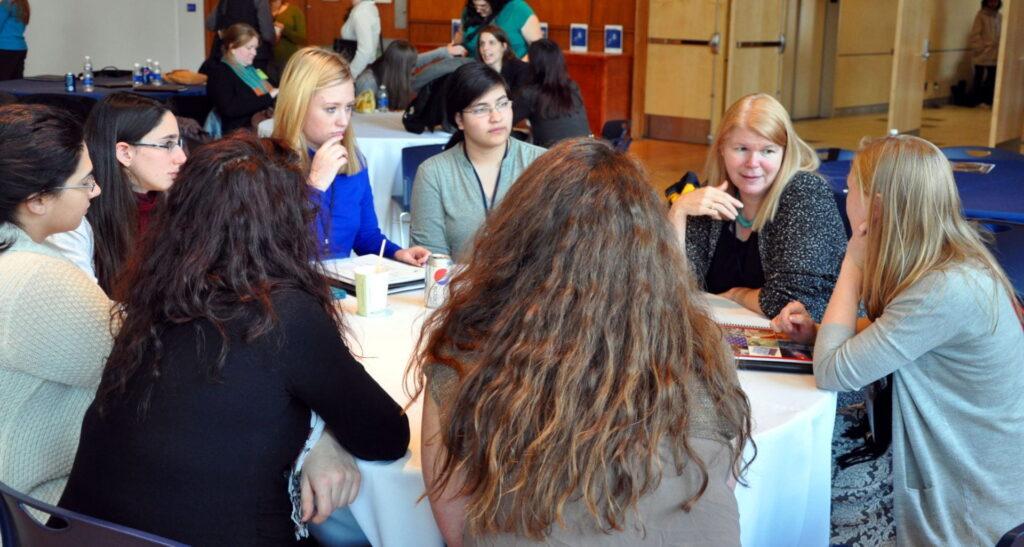The Georgetown University physics department participated in the first in-person Conference for Undergraduate Women in Physics (CUWiP) since 2019.
This year’s CUWiP took place from Jan. 20 to 22 at 15 different sites across the United States and Canada. Four undergraduate students who are studying physics and physics department Chair Amy Liu attended the Penn State University location of the conference. The regional conferences were designed to encourage women to continue in physics, and programming included career advice, graduate school information, ways to create a more inclusive physics environment, a poster session highlighting undergraduate research projects and a chance to network with fellow female physicists.

Each CUWiP regional conference is organized by graduate students and faculty from the host university, allowing for a unique experience every year.
Harper Cartwright (CAS ’24) said the conference felt personal and impactful, helping her begin her physics career.
“You could tell that the grad students had organized it and put a lot of heart into it — from the welcoming volunteers to the very heartfelt speech the organizer gave at the end about ‘finding your light’ in grad school and in life,” Cartwright told The Hoya.
Allie Stevens (CAS ’26) said CUWiP was her first time being in a conference environment.
“I was looking forward to the weekend as a whole because I had never attended an event like this before, and I was really excited to see what it would be like,” Stevens said in an interview with The Hoya.
At the three-day conference, students heard from various professionals in the field including keynote speaker Nadya Mason, who currently serves on the Biden administration’s National Quantum Initiative Advisory Committee, and Katie Mack, a theoretical astrophysicist.
Stevens said Mack’s talk, which focused on both her research and career journey, was a highlight of the conference.
“My favorite part about the conference was listening to Dr. Katie Mack’s explorers talk on dark matter,” Stevens said. “I found her work to be very inspiring and introduced me to a topic that I may want to explore in the future.”
Mack’s book, “The End of Everything: (Astrophysically Speaking),” was published in 2020 and was named to The New York Times’ 100 Notable Books of that year.
CUWiP attendees could also sit in on parallel sessions, smaller sessions dedicated to single topics including “Applying to Grad School in Physics,” “Inclusion in STEM,” “Research in Earth and Mineral Sciences” and many more.
While these sessions were much smaller than the large keynote events, for some attendees, they were a highlight.
“The part I didn’t anticipate liking so much were the parallel sessions,” Cartwright said. “They were small, allowed for many questions and had genuinely helpful advice. I particularly liked the session I went to on geoscience because they were very frank about what getting into the field was like while also being encouraging.”
Liu spoke on the “Applying to Grad Schools in Physics” panel and said these sessions helped students prepare for upcoming challenges in establishing a career in physics.
“There were informative panels, exciting research talks, inspiring speakers, and plenty of opportunities for participants to share advice and experiences with each other and with women physicists at all stages in their careers,” Liu wrote in an email to The Hoya.
In 2020, women accounted for 25% of all bachelor’s degrees in physics awarded in the United States and 21% of all doctorates in physics, according to the American Physical Society (APS).
Although these numbers have increased in recent years, women remain underrepresented in the field when compared to other academic fields, according to the American Institute of Physics (AIP).
This disparity is even more apparent among women of color. A 2016 AIP report showed that Black women accounted for 4% of physics bachelor’s degrees, and Hispanic women accounted for 7% of physics bachelor’s degrees.
To encourage and support women to pursue degrees and careers in physics, the University of Southern California organized the first CUWiP in 2006. Six years later, the APS took ownership of the conferences, holding multiple conferences across the country at various participating universities.
This year, there was an emphasis on improving diversity within the field of physics. Many speakers spoke on initiatives they are leading both within APS and at their local universities, including the APS Inclusion, Diversity and Equity Alliance, which aims to strengthen diversity, equity and inclusion (DEI) within physics. One parallel session, “Recognizing and Responding to Bias,” was dedicated to tackling DEI issues head-on and provided attendees with tools they could take back to improve diversity on their campuses.
CUWiP has provided many young physicists with a chance to foster their passion for the field early on, according to Liu.
“I wish CUWiP had existed back when I was an undergraduate!” Liu wrote. “I hope that it was an empowering experience that left students excited and confident about doing physics.”













